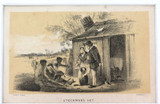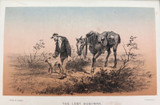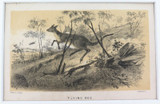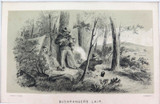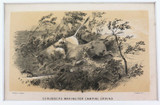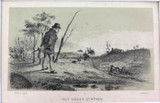Description
RARE 1859 COLONIAL ART. S T GILL TINTED LITHOGRAPH "RAMBLES in the ANTIPODES"#12
HNCO has purchased a rare collection of tinted lithographs by the famous Australian Colonial artist S T Gill (Samuel Thomas Gill) These were published in the 1859 book "Rambles in the Antipodes" by Edward Wilson. The initials STG can been seen bottom left corner. They are 100% genuine & not later issues. All have been professionally matted on acid free white cardboard ready to frame. The overall size of the matting is 30cms x 26cms, the paper size is 14.5cms x 9.5cms with the lithograph being 13.4cms x 7.5cms. His original watercolours are extremely hard to obtain, but when they do appear on the market, they rarely sell for less than $20,000 !!
This lithograph is entitled "The Found Bushman". Some minor foxing & marks otherwise in very nice condition.
Samuel Thomas Gill (1818-1880), painter, was born on 21 May 1818 at Perriton, near Minehead, Somerset, England, the son of Rev. Samuel Gill, Baptist minister, and his first wife, Winifred Oke. Gill was educated at Plymouth in a school kept by his parents, and later at Dr Seabrook's academy. He had some instruction in drawing from his father, who was an amateur artist. Gill was employed in London as 'Draftsman and Water Colour Painter' by the Hubard Profile Gallery, an establishment which produced silhouettes.
He reached South Australia in December 1839 in the Caroline with his parents and a brother and sister. In March 1840 he established a studio in Gawler Place, Adelaide, which was open from 'eleven till dusk'; he offered to produce portraits of human beings, horses and dogs, and to sketch houses and transfer the sketches 'to paper suited for home conveyance'. In 1846 he went without pay as draftsman with an exploring party led by J. A. Horrocks which reached the country at the head of Spencer Gulf. Gill was with Horrocks when he had a gun accident from which he died just over three weeks later. Gill nursed Horrocks devotedly and Gill's poignant diary of the expedition was published in the South Australian Gazette and Colonial Register, 10 October 1846. The explorer discovered and named Lake Gill (Lake Dutton). In Adelaide in 1846-47 Gill raffled drawings of the expedition and many of these survive; some remained in the possession of the Horrocks family until 1944 when they were bought by the National Gallery of South Australia. In 1847 South Australia Illustrated by George French Angas was published in London; in it was a series of hand-coloured lithographs of which at least two were after water-colour drawings by Gill: Plate 41 'Adelaide. Hindley Street, From the corner of King William St.' and Plate 54 'The Departure of Captn. Sturt. August, 1844'. A third lithograph, Plate 7, may be after Gill. These three works are typical of the many water-colours of urban scenes which Gill produced in Adelaide in the 1840s. In 1849 a series of twenty-two lithographed drawings of prominent South Australian citizens called 'Heads of the People' was published in Adelaide; Gill sketched these from life and drew them on the stone, and at the time the portraits were accepted as admirable likenesses. Other lithographs by him published in Adelaide in 1851 were of the 'Old Colonists Festival Dinner' and of a racehorse called 'Merry Monarch'; the latter indicated his lifelong interest in the turf.
In 1852 Gill went to the Victorian gold diggings, and in the next twenty years produced drawings of Victoria and New South Wales, many published as lithographs. Evidence of visits to New South Wales in 1856 and 1861 exists in the form of lithographs of scenes in that colony in those years. Twenty-four lithographed sketches by Gill, Victoria Gold Diggings and Diggers As They Are, were published in Melbourne and London in 1853; moreover, most of the illustrations in The Gold-Finder of Australia; How He Went, How He Fared, And How He Made His Fortune(London, 1853), said to have been edited but probably actually written by John Sherer, were taken from the book. In the 1850s Gill had a studio in Collins Street, Melbourne, over the premises of James J. Blundell & Co., booksellers and publishers. Victoria Illustrated, a book of steel engravings, not engraved by Gill but after his drawings, was published in Australia in 1857, and the colour lithographs in Edward Wilson's Rambles at the Antipodes (London, 1859) are after Gill's drawings. Gill's Scenery in and Around Sydney (1856) appeared in two parts, each including six 'lithographic sketches'. Several editions were published of The Australian Sketchbook by S. T. G., a portfolio of lithographed views, mostly of rural life. In 1869 he was commissioned by the trustees of the Melbourne Public Library to do forty sketches of the Victorian goldfields during 1852-53. After 1870 Gill fell into obscurity, though he continued to produce work, some of it in the nature of cartoons which were coarse in execution. On 27 October 1880 he collapsed in Post Office Place, Melbourne, and was found to be dead when taken to hospital. The next day an inquest was held and the cause of death was found to be 'rupture of an aneurism of the aorta'. His grave in the Melbourne General Cemetery was unmarked until 1913 when his body was moved to a private plot in the same cemetery and a stone erected, paid for by funds collected by the Historical Society of Victoria. He never married.
No work in oils by Gill has been traced, but at the age of 16 he painted a self-portrait in oils, now destroyed. What survives of his work is confined to numerous drawings, in many cases in water-colours, and to many prints, usually lithographs. He has been called the 'Artist of the Goldfields' but he was more than that, and it is unfortunate that the successful publication of lithographs and of engravings after Gill's drawings, after he moved to Victoria in 1852, has so largely dominated his reputation. His South Australian drawings of the virgin landscape show an appreciation of the rounded hills of the Mount Lofty and Flinders Ranges, and his many charming topographical drawings done in the 1840s provide an unrivalled record of buildings in the infant capital, Adelaide, and in its port. Two sets of drawings of suburban houses-Vale Farm, Walkerville, and Prospect House, Prospect-done by Gill for their owners are in the National Gallery in Adelaide. Gill also made many drawings of the Burra Burra copper-mine whence came the wealth of J. B. Graham, owner of Prospect House. In spite of his service with the Hubard Profile Gallery in London, Gill's efforts as a portrait painter in Australia were not extensive; his advertisement in the South Australian Register, 7 March 1840, shows that it was mainly portrait work at which he aimed when he migrated. But except for the admirable set, 'Heads of the People', Gill left little of that kind of work; perhaps he did not later attempt much of it because of the trouble involved, perhaps because he was working in the dawn of the age of photography; in 1845 Gill imported the apparatus for making daguerreotypes but no photographic work of his has been traced.
Gill usually worked in landscape or townscape, often with figures of human beings and with horses and dogs, much in the manner of Rowlandson, but without Rowlandson's genius for line. In South Australia Gill's work was marked by delicacy and care, but he will no doubt be remembered mainly for the work he did after he left that colony, and particularly his convincing pictures of life on the diggings, which he executed with great vitality and gusto. Collections of S. T. Gill's work, both original water-colour drawings and prints, are in the National Library, Canberra, the Mitchell Library, Sydney, and the National Galleries of Victoria and South Australia, and the Art Gallery of New South Wales.
Always happy to combine postage where possible & practical. HNCO are not responsible for import duties or customs charges. This is the buyers / importers responsibility.
Reviews (0)
Be the first to review this product.
Additional Info
- Gift wrapping:
- Options available
- Shipping:
- $10 (Fixed Shipping Cost)





